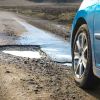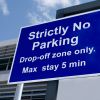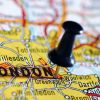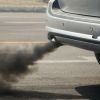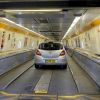For drivers, the plans attracted attention for two reasons: Firstly, the new proposed runway would need to be built over the M25, signalling major work on the UK’s busiest stretch of motorway.
Secondly Heathrow Airport announced plans for a Heathrow Ultra-Low Emissions Zone and a longer-term Vehicle Access Charge to access car parks and drop-off areas within its perimeter. Concerns were raised about the impact of both of these on traffic volumes and increased costs for drivers, but what will Heathrow expansion mean in reality?
Heathrow third runway impact on the M25
Over 200,000 vehicles use the stretch of the M25 near Heathrow Airport every day, with the section between junctions 14 and 15 being the busiest, with almost a quarter of a million daily journeys. But why is this stretch of road so busy?
RAC head of roads policy Nicholas Lyes said: "The problem with this stretch of the M25 is you have strategic journeys – such as HGVs and long-distance business journeys – mixing with local traffic, commuter traffic and leisure traffic on its way to the airport.
"Additionally, junction interchanges taking traffic to the West Midlands via the M40, the West Country and South West via the M4 and M3 all converge with the M25 in its south-west quadrant. This creates one of the busiest stretches of road not just in the UK but in Europe. Regular users of this part of the M25 seldom reach speeds of 70mph here and it can often resemble a car park during peak hours."
Some might think that the building of a new runway over the motorway and the required work on improving capacity could create virtual standstill and many years of delays, road closures and congestion – but what will the reality be?
Heathrow’s programme team overseeing the construction have come up with a solution which means the majority of the work to the M25 will be done ‘offline’, or in effect ‘off-road’, with construction taking place next to the existing M25 which will still be running normally.
Heathrow third runway proposed roads and transport connections
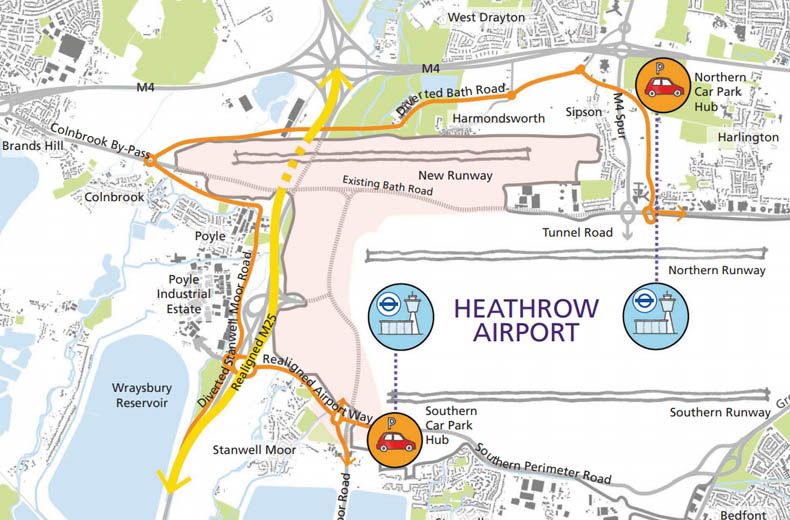
Heathrow anticipates that that the biggest challenge is likely to be linking up of the existing stretches of the M25 at the north and south ends with the stretch of the motorway. Heathrow has proposed around 6-9 months of night lane closures taking place, maintaining the full M25 operation at all other times.
While discussions between Highways England and Heathrow are ongoing, drivers will eventually see an M25 with more running lanes and less lane merging of traffic, which will allow for simpler and smoother journeys with easier wayfinding. The airport has committed to cut car journeys and wants to see at least 50% of all passenger journeys to and from the airport be taken by public transport by 2030.

RAC sale – up to 33% off*
• Roadside cover from £5.29 a month†
• We get to most breakdowns in 60 mins or less
• Our patrols fix 4/5 breakdowns on the spot

Heathrow Ultra-Low Emission Zone and Vehicle Access Charge
To continue to improve air quality around the airport and reduce congestion, Heathrow has announced plans to introduce the world’s first airport Ultra-Low Emission Zone (the Heathrow ULEZ) as a form of road user pricing from 2022.
It is likely that the zone will introduce minimum vehicle emissions standards identical to the London ultra-low emission zone, meaning petrol cars that will comply with emissions standards are generally those registered with the DVLA after 2005 and diesel cars that will meet the standards are mostly those registered with the DVLA after September 2015. Older vehicles that do not comply with these standards will face a charge for entering the airport.
This will effectively introduce a ‘kiss and drop’ charge for polluting and non-compliant vehicles using the drop-off areas and car parks for pick-up or long-term stays. Heathrow estimates that only around 11% of vehicles will be non-compliant in 2022.
- The Ultra Low Emission Zone: what you need to know
- Everything you need to know about driving in London
With the opening of the new runway from 2026 and improvements to public transport access, the airport has also indicated it plans to roll-out a wider ‘vehicle access charge’ which will replace its Ultra-Low Emissions Zone. This will be introduced in 2026. The goal is to not only help protect local air quality by tackling emissions, but to significantly reduce congestion and help drive further investment in sustainable transport.
Initial proposals for the Heathrow ULEZ could set the charge figure between £10-£15, in line with the charges set by the Mayor in central London. There is no final figure on what these charges will be to drivers, however it is important that motorists are aware for future reference.
Heathrow is consulting on the Heathrow ULEZ in its Airport Expansion Consultation, due to close on 13th September 2019. Exact details for the Heathrow ULEZ will be confirmed when the airport submits its final DCO application for expansion after public consultation.
Tony Caccavone, Heathrow’s Director of Surface Access, said: "With our Surface Access Strategy - including the proposal to introduce the Heathrow Ultra-Low Emissions Zone, we are taking big steps to address air quality and congestion around the airport, and to make sustainable transport a better and more convenient choice for passengers and our colleagues.
"The works to the M25 will deliver an expanded motorway with improved wayfinding, helping to alleviate any bottlenecks drivers currently face. We are working closely with Highways England and will ensure that the M25 will be kept open throughout the construction process, with the works taking place alongside the existing motorway."
Is it illegal to drive without shoes?
Get the answer and more useful driving content sent straight to your inbox.





